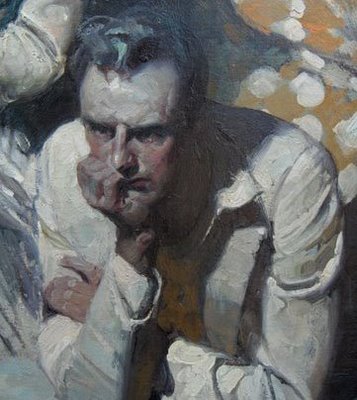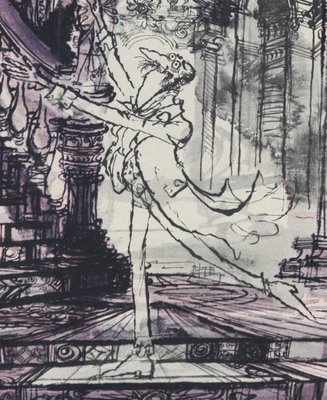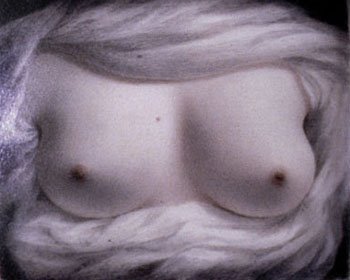The great illustrator Dean Cornwell applied oil paint like he was buttering a croissant.

I see this painting every day, and the pleasure I take from it is both visual and tactile. Cornwell's artistry is revealed at the exact place where his imagination interacts with the physical universe-- the stretched canvas that first yields and then springs to the touch, the sable brushes that spread, flex and taper as they sculpt the colors. I know this artist better for the sensuous experience of running my fingertips lightly across this painting.
As another example, Ronald Searle dips his pen in his DNA. He scuffs, scratches and scribbles on paper with ink, water and color to create an object which reveals his identity more than any fingerprint ever could.

I am sure that Searle could have increased the efficiency of his output by using the photoshop deflavorizing machine to erase mistakes (and to miss out on happy accidents). I'm not sure the result would be quite as personal.
My third example, a painting which I wrote about recently, has a different kind of physical significance. It is smooth and polished, with a surface that is visually not much different from a digital image.

Its significance stems instead from the way the artist invested a small piece of ivory with enormous emotional importance. With each of a thousand tiny brush strokes, she probably wondered whether she was doing the right thing. With a thousand and one alternate brush strokes, she was probably exhilarated by the prospect of baring herself to her secret friend. It matters that there was a luminous object rather than a jpeg for her friend to clutch and hold close.
These examples show that a physical object can reveal additional qualities and add a different layer of meaning to art.
Art that exists only as database of electromagnetic pulses can be just as beautiful as physical art, but I think we reserve a special sympathy for art that shares the mortality of physical things. Computer art is not made of perishable substance, and for that reason will always be a little more distant from the core of human concerns. As Thomas Mann wrote:
Love is our sympathy with organic life, the touchingly lustful embrace of what is destined to decay.In this regard, computer art (which never erodes or crumbles and can be perfectly replicated endlessly) leaves us behind.
None of this means that computer art isn't superior for some purposes. I have been gratified by the comments from those of you who are also trying to make sense of this area. I concur with those of you, such as Szy or L.A. Stern, who appreciate the importance of an art object just as I agree with those of you like Stefan, John and Insomniac who see a great future for computer art. In the end, I am with those who say that the greatest potential for computer art is where it is not trying to mimic traditional media. I plan to spend a little more time exploring this neighborhood but before leaving "the importance of an object," I thought I'd offer you one last quote from my guy Walt Whitman.
His poem, Whoever You Are Holding Me Now in Hand speaks of the importance to his poems of a physical touch:
[I]n libraries I lie as one dumb, a gawk, or unborn, or dead,
But just possibly with you on a high hill— first watching lest any person, for miles around, approach unawares,
Or possibly with you sailing at sea, or on the beach of the sea, or some quiet island,
Here to put your lips upon mine I permit you....
Or, if you will, thrusting me beneath your clothing,
Where I may feel the throbs of your heart....
For thus, merely touching you, is enough— is best.

18 comments:
Extremely well said!
I haven't got a whole lot to say on the pros and cons, or the unfortunate loss of the physical with digital art that you haven't already eloquently stated. I too agree that there are strong, practical forces at work, the main one being time. If an illustrator can get a job done in half the time using a computer, then you're probably going to see more and more digital work.
Oddly enough, this is also a key point that Andrew Loomis makes in his book on figure drawing - that knowing how to draw the figure with or without reference is important because only knowing how to trace/copy simply isn't practical; that artists who only know how to copy will spend longer, more frustrating hours hacking away at a drawing to get it to look acceptable. Likewise, comic artists who write about the digital movement have few illusions about how important efficiency is in their profession.
Going off on a bit of a tangent, I think it's interesting to look back in the history of illustration. In the time before photographic reproduction techniques, artists use etchings or woodcuts and so on. Granted, few people would turn down the opportunity to own an original Rembrandt etching, but can you really appreciate the hard-to-see scratches on copper as well as after it had been "printed"? Furthermore, is it important to have a print directly from the etching, or will a modern reproduction do just as well? (Ignoring the monetary value and status, is it necessary to have an original Andy Warhol, or would a reproduction suffice?)
But because original artworks still have value, that people still want to buy them, and that they can still represent a significant portion of a starving illustrator's revenue, I don't think you'll ever see artists give up traditional media entirely. For all the romantic reasons to desire original artwork, I think there are just as many practical reasons that it's here to stay.
In closing, I'll just post a few links to some digital artists whose work I enjoy. Some pro, some amateur. I myself have been too frustrated by the tablet to get any good with it yet, and never want to leave traditional media behind entirely, but I sure do envy the gorgeous imagery some digital artists can produce in an amazingly short time.
http://chriswahlart.blogspot.com/
http://artbytheo.deviantart.com/gallery/
http://cattish.deviantart.com/gallery/
http://gizmodus.deviantart.com/gallery/
http://ukitakumuki.deviantart.com/gallery/
For the most part I agree. I wonder, though if the computer hasn't put even more tangible real world art objects in the hands of admirers. The one-a-day painters, the web galleries, vinyl sculpture, handicrafters, etc. are all using the computer to connect to the widest audience art has ever had.
ajlec2000, I agree with you. That's part of what makes it so difficult to assess the impact of computers on art (and as Bob Dylan said, "don't speak too soon for the wheel's still in spin"). Computers created wonderful reproduction and distribution systems that spread artistic images around the globe to places they would never otherwise have been seen.
For a while it looked like this technology would make deserving artists famous and rich. (Look at Frank Frazetta, for example, who got to keep his originals and still make a bazillion dollars from reproduction rights.)Now it appears that this technology thwarts copyright laws and assists plagiarism and stock work. Not such a good deal for the artist after all, but a boon for the audience.
Painting a Day is kind of a gimmick. I mean, do you think The Dean (Cornwell) did his painting in a day? Not likely!
The internet has given a good deal of exposure to painters whom many of us would never have otherwise seen (and many whom we really don't mind not seeing), so its great for artists and collectors alike.
I just don't see how computers ADVANCE art or picture making beyond animation. So what's the big deal about using a mouse over a paintbrush? I always thought that it was the painting that mattered. What gives paintings their value (monetary, to collectors) is their uniqueness. Knowing that, why would I go digital? Images are easy to swipe. Original paintings, not so much. In the age of effortless proliferation, it will be the original that retains its value. BTW David, having an original Cornwell is a rare priveledge! You lucky dog!
I guess you can sell copies of images made by computer, just like regular paintin's. But where's the original? What value does the original have? Its a lot more fun, I think, to paint with physical paint. I really am hopelessly retrograde.
I love the internet. But as far as picture making goes, some things are hard to top. I'd say the lowly paper and pencil is one of them. The paintbrush and canvas are not far behind.
It’s true that an artist can’t learn to draw sat in front of a computer screen. But for an illustrator working in editorial to very tight deadlines, digital art is ideal for emailing straight to publishers who can drop it into their desktop publishing programmes.
Calling "painting a day" a gimmick is a little rough. I think most artists do them as an exercise or a discipline and a kind of visual diary. Looked at on their own merits, they can be very interesting.
Off the topic, though, Sorry!
I agree ... the "painting a day" remark was unnecessary and unwarranted. Just like physical exercise, working your craft everyday is great practice, demonstrates discipline and builds strength and opportunities for discovery. I wish I had the discipline AND the courage to put my work out their every single day. My hats off to all the artist who do it... digital and traditional both.
In fact, I think that artists are not given enough credit for thier bravery. It is easy to be an arm chair critic. It is much harder to put yourself and your work out there -- now electronically -- for all the world to take snipes at... or admire. We should be more supportive of eachother as artists pushing through the creative process, no matter the media. God knows there are enough people out there ready to hammer down any nail that sticks out...
I think the painting a day remark is fine. I don't understand why people think you can't work everyday on a larger or more complicated task that takes a few weeks or months to complete. A lot of the illustrations many here admire took longer than a day, some by far. I think it is a gimmick and it ties right into the plein air movement and modern art where all the emphasis is on spontanaeity, and not on the final quality of the work. It must be part of the artist-as-divinely inspired idea, and not the artist as a craftsman idea. I like plein air painting, and do it a lot myself, but most good landscape painters use them as studies for larger works, even though they sell the plein air studies.
I think artists are given too much credit for being extraordinary, which in your description, would be "bravery". I can think of a hell of a lot of other jobs that require far more bravery than painting a picture. It would be nice to return to a time or attitude where painters are are seen as being just like anyone else--people who aren't considered "(you're) so talented" slightly off-center kooks, but rather craftsmen who are talented and hardworking like any other successful professional. Also it would be nice to see these craftsmen painting ordinary life, or finding the extraordinary in the ordinary, and not gimmick after gimmick to draw attention to themselves.
Also, I am not an armchair critic. I paint pictures as well. I just don't do it for a living. I don't think the problem is that artists aren't supporting one another. I think the problem is that the general public isn't supporting the artists because we have largely ceased to make art that they find inspiring or that they can relate to. Yes, there are many other factors as well. But there's really no excuse for doing hurried up, simplistic, one-shot-deal work. We need less of that, at least I think so.
But spending a month on a painting does not fundamentally make it a better piece of ‘art’. I sometimes learn far more about what the artist was actually thinking from those ‘plein air studies’, the idiosyncrasy of the marks are as personal as someones handwriting.
I don't know if you mentioned it, but another boon the computer has provided to commercial illustrators is that it's easier to change something if the client wants it, without the illustrator crying so many tears, or redrawing a whole picture (or chopping up, whiting over, or pasting onto the original in some way).
As a comic artist, I've always thought that the work of art was the printed thing. The original boards are interesting, but they're not coloured, and there are pencil marks and corrections the artist probably would rather you didn't see.
I remember reading how Chesley Bonestell had a teacher who required his students to contemplate a chair sitting in the corner of a room, and then determine exactly how it should look from a different angle with the sun shining through a window on it at a particular time of day. Today you push a button and a computer algorhythm figures it for you in a millisecond. But what is lost? Bonestell could close his eyes and travel millions of miles in his mind to envision how Saturn would look rising in the morning from Titan.
That's quite poetic, jack r, and quite compelling.
There's a backstory to the Bonestell Saturn as seen from Titan painting. After he made some preliminary sketches he built a detailed 3-d plastic model of the montains and experimented with different lighting schemes. I guess one might claim this was a 20th century version of what a computer program could easily render but Bonestell did it all with his own two hands.
Good thoughts, David. It's true that the physical object itself lends a certain elevation to a work of art. It is the fagility, the irreplacebility of a non-computer generated object which (in part) makes it particularly worthy of veneration. What the physical object gives us the ability to relate materially to the artist in a way that an endlessly duplicated jpeg cannot.
Computer generated art, like the printing press, gives us a greater measure of safety. Accidents or deliberate destruction cannot end the digital image, but it can for the fragile paint-covered canvas. Likewise the printing press preserves text from the expensive and error-filled process of hand copying. Despite the loss of object uniqueness that these technologies induce, we reap the benefit of preserving our history over the ravages of time.
I realize this thread has gone cold but it might be worth checking out the amazingly popular youtube video of a speeded up photoshop of a portrait. You get to see the artist go back and forth, repeatedly correcting mistakes and second guessing decisions. There are multiple changes in contrast, color, tone etc. The final product of all this technology is a middling drawing.
See it here:
http://youtube.com/watch?v=8K_NQe57C-k
I have been a high school art teacher for the last six years, teaching drawing and painting, but before that I worked as an illustrator in the Detroit area for over twenty years. Of course, early on my work was all done with traditional media. Eventually, I started producing digital art, mainly using Adobe Illustrator. Illustrator is an amazing program for producing flat graphic design-oriented art. The work can be done much quicker, and you never have to worry about things like marring the surface of a painted piece, which, when using flat colors, can be very difficult to fix. After the art is finished, alternate versions with different colors can be made very quickly, and changes requested by the client can usually be done quickly and easily.
When I left the world of commercial art and started to do more work strictly for my own enjoyment, I started thinking about things that I never really spent much time thinking about when I was doing illustration-- things about the nature and meaning of art, etc. One thing that has struck me, much more so now than before, is the fact that when you create a piece of digital art, in a very real sense there IS no "original art". The art, as a specific entity, literally does not exist. Now this never used to bother me in the least, nor does it bother me at all in terms of producing commercial art. However, I sometimes feel that a piece of strictly digital art has no "soul", no real essence. It only exists as digital information-- a series of 1's and 0's.
In contrast, consider an actual drawing or painting-- you can hold it, feel its surface, even smell it. It exists independently on its own, in the physical world.
I have an original oil painting created by my grandfather, and another oil painting made by my great great grandfather. These two paintings are two of my most prized possessions. (They are both excellent paintings, by the way.) I like the idea of thinking that years after I am gone, my sons, their children yet to be born, and perhaps even generations of my family beyond that will have some of my art in their possession, and perhaps they will feel the kind of spiritual connection with me that I have felt with my grandfather and great great grandfather through their artwork.
Yeah
Post a Comment